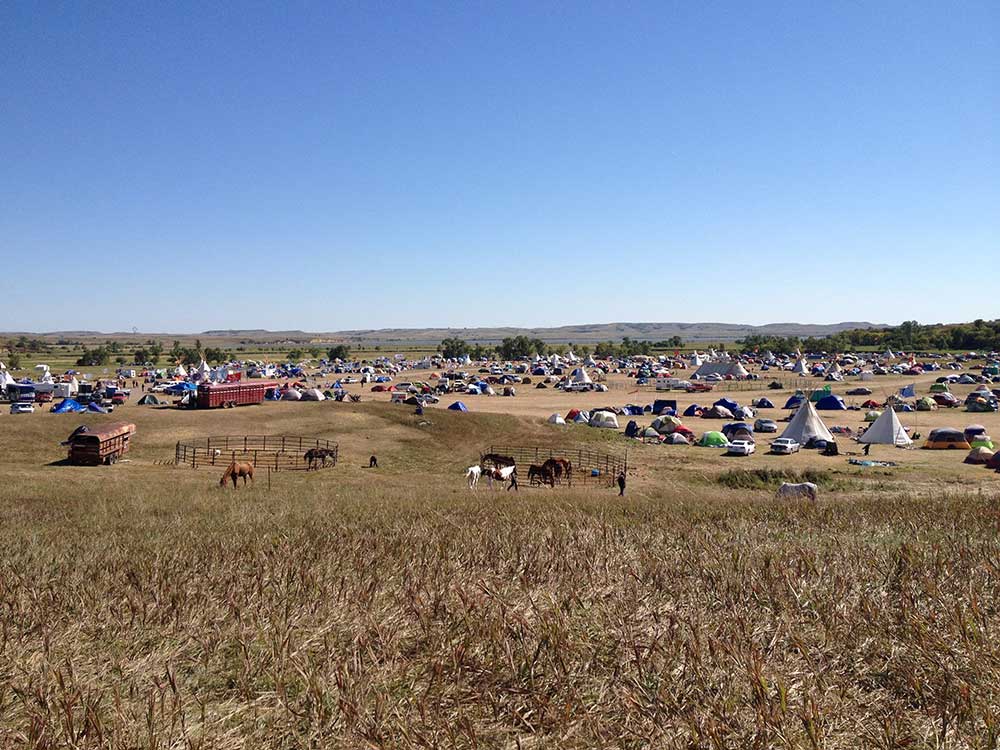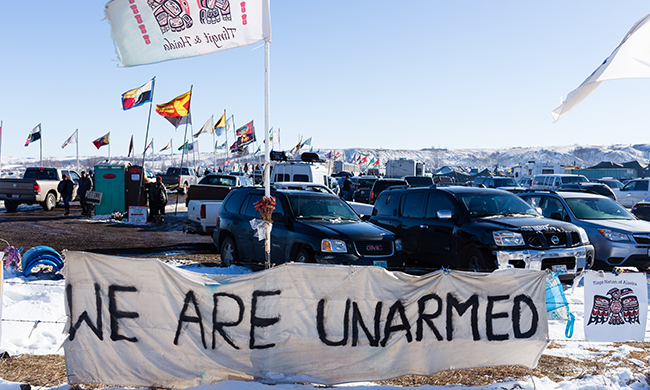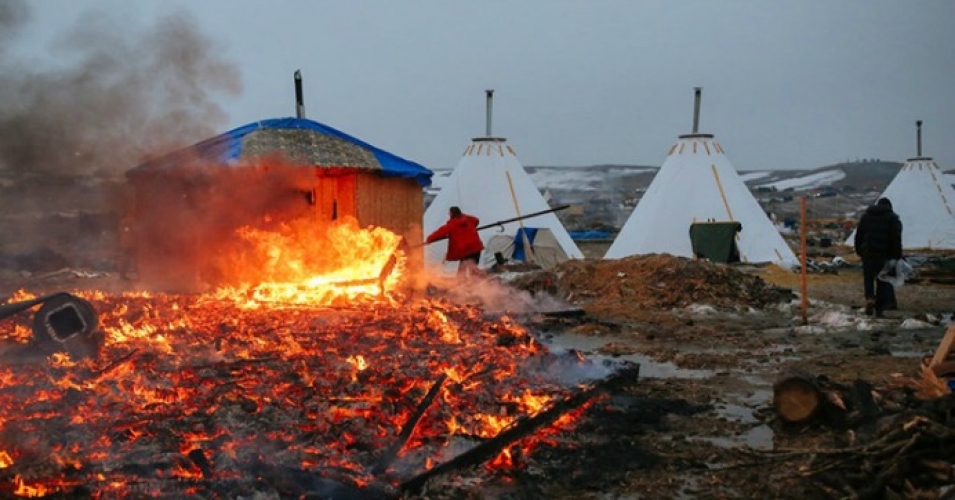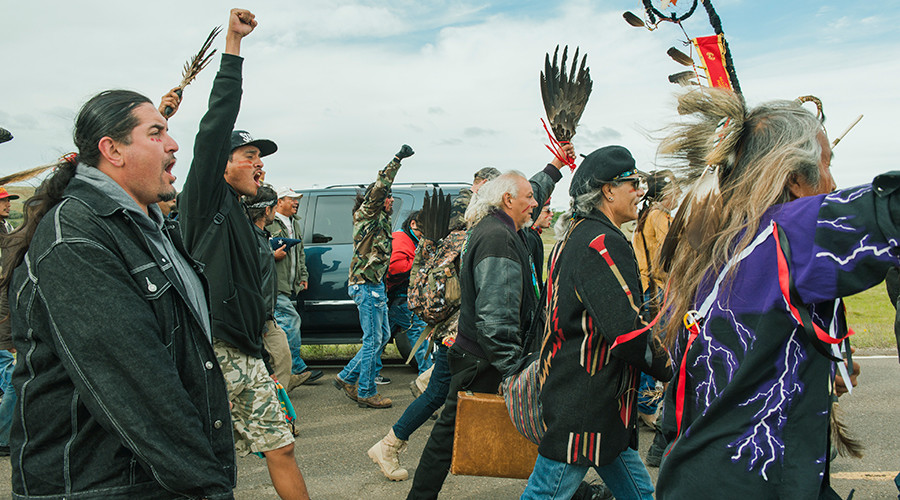There are still seasons in Standing Rock – for now. The contrast with Southern California, where I live, couldn’t be starker. The grass is green and lush, the air is fresh, the smell of rain never too far away, and the river winds through the meadows and between the hills full and with great purpose. The nights are growing cold and in the mornings our breath billows before us, white and steamy. I have just spent a week at the Standing Rock encampment that sprung up in April this year and which has grown in size and national significance this past summer.

The river under which the pipeline would be placed
Here at Standing Rock, North Dakota, the largest gathering of different indigenous nations ever seen on this land is currently taking place. Over 280 indigenous nations and thousands of allies have answered the Standing Rock Sioux’s call for support in the face of the construction of an oil pipeline that will threaten their reservation’s water and livelihoods – and that has already desecrated sites of great cultural importance. Their resistance, rooted in peace and prayer (not to mention enormous bravery), has been a flash of hope in a summer heavy with bad news. Throughout the summer thousands have joined the camp to stand amongst and alongside indigenous nations against the bulldozers and security forces of the Dakota Access Pipeline. United behind the Lakota slogan Mni Wiconi, Water is Life, those camped here call themselves the Water Protectors and are committed to resisting the pipeline with non-violent direct action. Inspired by their strength and solidarity I travelled to Standing Rock to join them and help in whatever small ways I could.

The Oceti Sakowin camp, also called “The Big Camp”
Though my stay was far too short, it coincided with an important crossroads for the camp – both strategic and temporal. Throughout my stay I saw, or rather felt, these intense shifts take hold as temperatures plummeted and the camp was reinvigorated with purpose and power. My party and I arrived on Thursday 9th, the day before President Obama asked the pipeline company to halt construction pending a more thorough environmental impact review. Dakota Access, likely viewing a temporary cessation in construction as a welcome respite, and indeed a time to regroup against the unexpected groundswell of resistance, complied. Many large media outlets, which had only recently taken any notice of the camp, eagerly reported an overwhelming victory for the Water Protectors and the indigenous nations. However, the indigenous leadership at Standing Rock was sharper and more sceptical. Many speculated that all this was a part of a more insidious strategy to demobilize the Water Protectors before a counter attack could be mounted – all advised caution and vigilance.

Enormous thunderheads roll into the campsite
Over the following weekend temperatures dropped and much of the encampment, as I perceived it, seemed to have succumbed to feelings of uncertainty and anxiety. We ran into at least one group of campers who, believing the fight was over, packed up and left the day after Obama’s announcement. If offering this small victory was indeed part of a pernicious scheme to demobilize the Water Protectors, looking over an emptier camp on a cold Monday morning, I worried that it was working. The camp was still very large but considerable patches of green and brown grass had re-emerged in amongst the tents and tepees.

Blockades at the frontline
By Tuesday afternoon, however, it became clear that my fears were unfounded. With more arrests of Water Protectors engaged in non-violent direct action, the carefully timed NoDAPL nation-wide day of action and greater media attention, the camp’s population surged. The leading article on the front page of the local newspaper claimed that the camp’s numbers had swollen to 4000 people – and judging by the new tents popping up I believed it. Moreover, the camp’s certainty in its purpose had been restored: Stand firm for the winter, show that the Water Protectors are here to stay, and prove that the fight has only just begun. To this end efforts have been directed towards reinforcing the camp’s infrastructure, preparing it for the oncoming winter and sending parties further afield to block pipeline construction where it continues beyond the 20 miles of land protected under Obama’s request.

Indigenous artist and youth activist, Jackie Fawn, created this image which has gone viral on social media
Of the later days at the Standing Rock I wrote in my journal “A tangible difference has come over the camp. The cold has brought with it a renewed sense of purpose and defiance.” As the mornings grew colder and the air grew crisper, I found it harder to rouse myself from the warmth and comfort of my sleeping bag, but the chores of the day and our restored certainty in our cause was usually enough to get me up… eventually. Each morning, after clambering laboriously out of the little tent I was sharing with Emily I would look up to the sky and see legions of geese making their way to warmer climes in classic V-formation. They are beautiful and elegant against a backdrop of high grey-white clouds. They also serve as a reminder of winter’s looming presence. Marty-Joe, one of two sisters who own the land upon which the Sacred Stone camp has been erected, told us that the first snow always comes to Standing Rock before Halloween – just a month and a half away. Despite our rapidly changing climate, the cold mid-September days suggests that this will hold true for another year at least. So there is work to be done and we are there to help in it.
After a quick breakfast, usually of oatmeal and fruit from the vast stocks of food donations that have come piling in from across the country, we get to work. Under the close instruction of Tiffany, Emily and I are working with Nancy on inventory of supplies. Emily and I are sorting through enormous stacks of clothing donations. We split them into categories and wrap them in weatherproof bags before sending them up to the larger winter storage tents that others at the camp have erected a little way up the hill. Meanwhile, Nancy tirelessly sorts and stows sleeping bags, blankets and towels. The work is inspiring – because so much has been sent so generously by so many people across the country – and unexpectedly strenuous, for the same reason. We clear a space of clothes and immediately it is refilled as another box of donations is brought up to us. This place could withstand a siege, and it may just have to. I joke that with every new box of donation coming in we are like Sisyphus, condemned to spend eternity rolling a boulder up a hill only for it roll down again once the summit is reached. But the work isn’t really that bad and the satisfaction we feel, flexing aching muscles, knowing that we are doing something that is actually useful to the camp is enough to keep us at it for several hours a day.

Water Protectors sprinkle tobacco at the front lines
As we work we get to know Nancy, a Quaker from Boston, who says she ended up at the camp somewhat by accident but once in North Dakota felt called to join us. Nancy is one of those truly good spirits who, through her simple integrity, moves all those around her to better themselves. Some way into her 60s she takes on double the work we do and continues long after meals have been called. Our work is useful but it is hardly heroic stuff. Emily and I are painfully aware that unlike many at the camp we aren’t risking our lives or putting our bodies on the line, facing off with bulldozers and attack dogs. But you get in where you fit in as they say, and for various reasons neither of us are in a position to get arrested. We discuss this with Nancy and she reminds us of the importance of the enormous effort required behind the scenes to ensure those on the front lines can be sustained in their activism – and we feel a little better.

My travelling companions: Francisco, Emily and Minh
At lunch the camp converges around the main fire pit. Prayers are said, sage is burned and yet more volunteers, often including Marty Joe, who seem to be permanent fixtures at the kitchen tent, dish out strength-restoring nourishment. After lunch, Emily and I either return to our work or we join our travelling companions, Francisco and Minh, and cross the river to the big camp. We are staying at Sacred Stone camp on the Standing Rock reservation but the Oceti Sakowin camp across the river is bigger and often called the overflow camp or the big camp because as Sacred Stone filled up many crossed the river to set up tents on land just outside the reservation. At the big camp we try to gather what updates there are, connect with friends Francisco has made, or we take part in medic trainings and non-violent direct action trainings.

Banners line the fence around the construction site
After lunch on our final day, we marched with 200 others from the avenue of flags lining the main road through the big camp. We walked a couple of miles to where Dakota Access went out of its way to bulldoze the ancient burial sites of the Sioux’s ancestors. As I was given to understand, each day marches of this sort left the camp as a ceremony of recompense for disturbing the ancestors. It was a solemn affair but seeing the site of such gratuitous violence was an important reminder of the struggle we’re in. When we reached the site an Elder sang prayers, a few words were said, sage was burned, and our respects given. Before leaving we were instructed to sprinkle tobacco over the site. On our way back to the big camp we passed the front lines where Dakota Access had pulled up its equipment away from the construction zone. Banners bearing slogans of defiance and hope and the words “Water is Life” had been tied to the fence to mark the spot – the spot where tragedy had, for the moment, been averted. We stopped and sprinkled more tobacco. For me, seeing the front lines was even more powerful than taking part in the ceremony and I vowed to redouble my efforts to support this struggle from afar.

Sunset over the river as we walked back to Sacred Stone camp
The evenings are times of some temporary calm here – the sunsets, always staggeringly beautiful, bring with them a cool tranquillity that envelops much of the camp before fires are lit, food is eaten, and songs sung. At the Sacred Stone camp, the smallest and oldest of the three camps facing each other across the river, the central fire pit is stoked, food for 100 is prepared and shared in common. Many gather round the camp’s main fire, for supper is a time of deep reflection and rich conversation. Before meals are taken, sage and tobacco are burned and mix with the wood smoke most pleasantly, an Elder offers a prayer and a plate is put aside for the ancestors of those indigenous to this land. Perhaps because it is a time when everyone at the camp comes closer together, perhaps because meals are a time for sharing, or maybe because meals are highly ritualized in most cultures, it is at mealtimes that the differences between the ancestors of white colonizers and indigenous people become most apparent to me. We talk of our differences openly but I am very aware of my whiteness and of its history in these spaces. I learn a lot about myself and about indigenous cultures during these conversations and I hope to write about all I have learned soon.
One afternoon, Francisco, who spent much of his time at the camps befriending young indigenous activists, told us about the International Indigenous Youth Councilthat was meeting that night. We were allowed sit in on the council and it had a powerful effect on me. The young people, much closer to me in age and, as I found, in outlook, were welcoming and friendly. They spoke intelligently of the state of affairs at the camp, of their role in it, of preparing for winter, of supplies needed, of media and the power of symbols, and of expanding their three-week old organization into a global network. Of all the different groups I have met here, all with the different theories of change, I have found the IIYC to have one of the most sophisticated. They are radical, they are not held back by crude respectably politics, but they are also strategic and understand power and persuasion better than most. The youth council closed with a song by the indigenous poet and musician Lyla June of the Diné Nation called All Nations Rise. She sang with such incredible beauty and poignancy that every one of us was left deep in silent reflection before thanking her from the bottom of our hearts.

Photos aren’t allowed in the Sacred Stone camp so here’s one of directions to the site
As we walked back from the council and the night settled in, the sounds of other songs, drums and flutes drifted across the river and were met with the defiant hip hop of the big camp’s indigenous youth and the prayer chants of their Elders. They rose and joined with songs from the Civil Rights era from some other part of the camp, and then yet more singing from other historic struggles for freedom and hope combined with them. We listened on the bridge as they all mixed together at the river and were carried away through the night. The songs spoke to me of solidarity, of resistance, of resilience, of hope and of peace – all the things this camp stands for and will continue to stand for. The camp is preparing for the winter, it will stay through the winter, it will stay for as long as the pipeline, the black snake, as many there call it here, is alive. They are there fighting for our collective future, for the water and for their lives. Though I am no longer with them I will continue to support them in what ways I can from afar. They are resilient and strong but if they are to last through the winter they will need solidarity to hold them together. We can and must support them in this. Lyla June finished her song with these words and I can find no better ending to my own writing than what she had to say:
“They say that history is written by the victors but how can there be a victor when the war isn’t over? The battle has only just begun and Creator is sending his very best warriors. And this time it isn’t Indians versus Cowboys. No. This time it is all the beautiful races of humanity together on the same side and we are fighting to replace our fear with love. And this time bullets, arrows, and cannon balls won’t save us. The only weapons that are useful in this battle are the weapons of truth, faith, and compassion.”
–––––-*
If you are moved to and are able please consider donating to one of the following…
- You can donate to the Standing Rock camp directly here.
- Many brave people are putting their bodies on the line so you can donate to the Red Warrior legal fund here.
- You can donate to our own GoFundMe here. We’re trying to raise enough money to send a medic tent of the highest quality to the Red Warrior Camp as fast as we can!
- You can check the Sacred Stone list of needed supplies here and send them gear for the winter.
There are also many other ways of showing support…
- Look out for the next solidarity action near you and join it.
- Find out if your bank is funding the pipeline project (it probably is) and pressure them to divest. Or divest from that bank. A list of banks supporting the project ishere.
- Finally, get people talking about this struggle – Make sure everyone knows this is peaceful resistance, that it is working and that it isn’t going anywhere!
















































